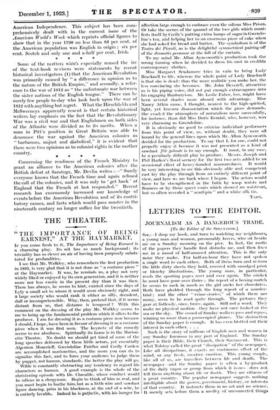THE THEATRE.
"THE IMPORTANCE OF BEING EARNEST," AT THE HAYMARKET.
Jr you come fresh to it, The Importance of Being Earnest is a charming play. Its wit has so much background ; its triviality has so clever an air of having been purposely substi- tuted for profundities.
I see that Mr. Walkley, who remembers the first production in 1895, is very glad that it is not done as " a costume piece " at the Haymarket. It was, he reminds us, a play not very widely liked or enjoyed by its own generation, and it is neither more nor less exotic in the present day than it was then. There has always, he seems to hint, existed since the days of Lyly a small set to whom it would seem obviously right, and a large society who would rank it either as silly, decadent, dull or incomprehensible. Why, then, pretend that, if it seems distant from us, that distance is temporal ? With this comment on the dressing of the play Mr. Walkley seems to me to bring up the fundamental problem which it offers to the producer. I am for dressing it as a costume piece now because I should, I hope, have been in favour of dressing it as a costume piece when it was first seen. The keynote of the comedy seems to me aloofness. Spiritually its home is in the Marion- ette Theatre. No doubt we should get tired of some of the long speeches delivered by these little actors, yet essentially Algernon Monerieff, Gwendoline Fairfax and Cecily Cardew are accomplished marionettes, and the more you can do to signalize this fact, and to force your audience to judge them by puppet, not human, standards, the better the play will go.
Wilde is constantly obstructing any tendency to regard his characters as human. A good example is the whole of the christening episode with Dr. Chasuble, whose conduct would be odious in a clergyman. Begin to think of him as real, and you must begin to loathe him, but as a littleNVire and sawdust figure dancing, prim in his blackness, at the end of a wire, he is entirely lovable. Indeed he is pathetic, with his hunger for affection large enough to embrace even the odious Miss Prism. Or take the scenes of the quarrel of the two girls which mani- fests itself by Cecily's putting extra lumps of sugar in Gwendo- line's tea, and helping her to an enormous piece of cake when she had asked for bread and butter. The symbolism is of the Teatro dei Piccoli, as is the delightful symmetrical pairing-off of the dramatis personae at the fall of the curtain.
To my mind Mr. Allan Aynesworth 's production took the wrong turning when he decided to dress his cast in credible contemporary clothes.
Miss Margaret Scudamore tries in vain to bring Lady Bracknell to life, whereas the whole point of Lady Bracknell is that she is dead : thus the more realistic you make her, the less convincing she becomes. Mr. John Deverell, attractive as is his piping voice, did not put enough extravagance into his engaging Bunburyism. Mr. Leslie Faber, too, might have been several shades more absurd with advantage. Miss Nancy Atkin came, I thought, nearest to the high-spirited, light, yet bravura disassociation which the piece demands. She evaded the atmosphere of naturalism more successfully.: for instance, than did Miss Doris Kendal, who, however, was very charming as Gwendoline.
It is obviously no good to criticize individual performers from this point of view, as, without doubt, they were all bound by the general lines upon which Mr. Allan Aynesworth decided for the production. To say that I, for one, could not properly enjoy it because it was not presented as a kind of sawdust fete galanle is to say enough. It must, in any case, be a peculiarly difficult play to produce. Messrs. Joseph and Phil Harker's florid scenery for the first two acts added to an occasional effect of heavy-handed unawaredness. It would be very interesting to see this obviously able and competent cast try the play through from an entirely different point of view, and here we are back where I began. The actors would have to be strengthened in the faith by wasp waists and flounces or by those queer coats which showed no waistcoat, but so often revealed a " scarf-pin " and a white silk tic.
TARN.


























































 Previous page
Previous page